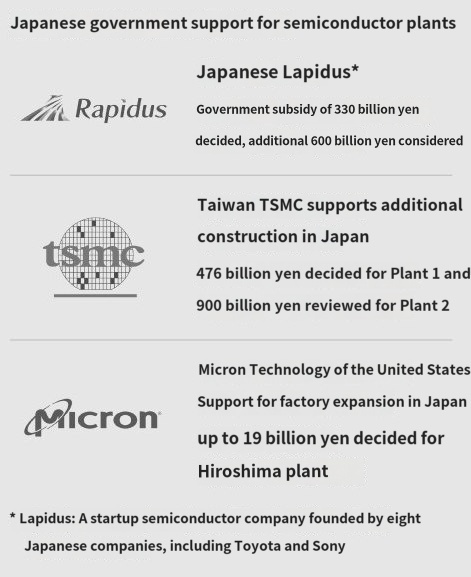
Investing money into ‘resurrection of semiconductors’
The Asahi Shimbun reported on the 12th that the Japanese government is pushing for an additional 3.4 trillion yen (about 30 trillion won) to foster the semiconductor industry in the country. Japan has already invested 2 trillion yen in the semiconductor sector. The intention is to revive the collapsed semiconductor industry by continuing to pour enormous government funds.
Citing multiple Japanese government officials, the Asahi Shimbun reported that the Kishida Cabinet is considering including up to 3.4 trillion yen in subsidies for the semiconductor industry in economic measures announced later this month. Semiconductor support was cited as the top priority of this economic measure. The newspaper said, “Japan’s Ministry of Economy, Trade and Industry plans to reflect this in this year’s supplementary budget and demand it from the Ministry of Finance.” Additional subsidies will be reflected in three funds: the “Post 5G Information and Communication System Base Reinforcement Research and Development Fund,” “Specific Semiconductor Fund,” and “Stable Supply Support Fund.” In the past two to three years, the Japanese government has established three funds one after another and put in a total of 2 trillion yen in government funds. A significant amount of this has already been executed for the construction of semiconductor factories.
The biggest beneficiaries of the additional measures are Lapidus, a Japanese semiconductor company, and TSMC, Taiwan’s world’s largest semiconductor foundry (consignment production) company, which is pushing to build a second plant in Japan. Lapidus, a semiconductor company jointly established by eight Japanese companies, including Toyota and Sony, in August last year, has already received 330 billion yen in subsidies from the Japanese government, with an additional 600 billion yen in subsidies being mentioned. Lapidus aims to produce 2 nanos (nm is one-billionth of a meter) semiconductor, a high-tech product that will compete with Taiwan’s TSMC and Korea’s Samsung Electronics from 2027. Prime Minister Fumio Kishida sent a congratulatory video message to the groundbreaking ceremony of the plant last month in Chitose, a small city of 100,000 people in Hokkaido. At the time, Prime Minister Kishida declared, “People who symbolize public-private cooperation and international solidarity gathered here to restore the semiconductor powerhouse,” and “We will strengthen the semiconductor supply chain in connection with you in the same 志n countries.” This means that it will re-establish the Japanese semiconductor industry with the help of foreign companies such as Dutch semiconductor equipment maker ASML, IBM in the U.S., Applied Materials, and RAM Research. The Yomiuri Shimbun said, “The Lapidus’ 2-nano factory is a large project that requires a total investment of 5 trillion yen.”
Taiwan’s TSMC will provide subsidies of up to 900 billion yen to the second semiconductor plant to be built in Japan. Japan previously provided 476 billion yen to the first plant under construction by TSMC in Kumamoto Prefecture. It provided nearly half of the total construction cost of Kumamoto Plant 1. The Kumamoto plant is scheduled to be fully operational at the end of next year.

Japan also plans to provide 1920 billion yen to Micron Technology, a U.S. memory semiconductor company, to expand its Hiroshima plant. Samsung Electronics and SK Hynix are not eligible for subsidies from the Japanese government because they have not established semiconductor plants in Japan.
KS CHOI
US ASIA JOURNAL



